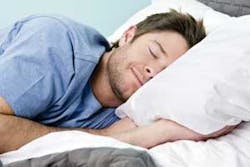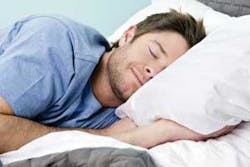Clenching and grinding
Examining the reasons and options
by Connie L. Sidder, RDH, BS
Here’s a surprising statistic! “Nocturnal bruxism occurs in 5% to 20% of adults and in 30% of children in the age group of five and six years.”
If so few of our patients are bruxing, why do so many of them sleep with nightguards?
Patients that suffer from headaches and increased tooth sensitivity are in need of help. There are different approaches to helping, however. Ask a dentist if he can help and you will most likely end up with a nightguard that fits over a complete arch and is made of plastic. Ask an orofacial myologist to help and you will get a lesson in proper resting position, as well as perhaps some relaxation exercises. And another system is the NTI, TSS (for tension suppression system) which fashions a splint to fit over the central incisors. This system is FDA-approved for migraine headaches.
Many years ago, my sister had a tooth that was getting increasingly sensitive. Having gotten a new crown, we checked the bite. I concluded that the crown fit well and needed no adjustment. I suggested to my sister that she must be grinding her teeth. What she learned was that she didn’t grind at night, but when stretching in bed in the morning! She would “gnash” her teeth to the point it made her crown sensitive. Now that she is aware of the problem, she is able to control it. I have used this information numerous times, and patients come back six months later stating that they, too, clench and grind upon awakening. (At this point, I usually send my sister an e-mail to let her know I’ve found another one!)
If one is able to use biofeedback, or basically just able to put the jaw at rest,
continued on page 87
you can eliminate unnecessary tooth-to-tooth contact. Biofeedback can be administered by experts with electrodes or self-suggestion. Many people appreciate the chance to take control without having to spend money on a problem they don’t even know they have. Many patients that have “flattened” molars and cuspids yet don’t experience headaches, jaw pain, or tooth sensitivity may benefit from orofacial myology techniques.
What is the proper resting position? With the lips closed, the tongue will rest in the roof of the mouth, and the teeth are not touching. In this position the facial muscles are relaxed and there is no tension. I advise patients that this can be checked when driving, at the computer, or even hourly during the day, if needed.
If patients are experiencing facial pain, incorporating moist, warm compresses over the masseter muscle can help to relax the face. Massage can be done for the head and neck as well.
If we listen to our patients, we can discover that many will clench at night periodically. For this, the principle that applies is that the last thing on the conscious mind can be transferred to the subconscious. Again, before dropping off to sleep, relaxation is imperative. The mantra to be used is: Lips together, tongue resting in palate, and teeth not touching. Have them clench and feel the masseter “jump” when teeth are in contact. This should awaken them and allow them to relax again.
A “hard-core” clencher is able to do this but awakens too many times a night to follow through. If one could follow through for three nights, the behavior is usually controlled. For these patients, a nightguard or NTI splint may be the better option. The idea behind the device is that the teeth don’t touch and the incisors are able to “rock” so as not to engage the temporomandibular joint.
For those who cannot wear a nightguard, or choose not to, the NTI splint (www.NTI-tss.com) is a good alternative. Combinations of treatments can be used. The approach to treatment can range from:
- Identifying when the clenching happens, such as driving, stretching, etc.
- Putting patients in touch with their relaxed state (lips together, etc.)
- Appliance use.
Many patients are thankful for the nightguard, without which they cannot sleep. To others, it is anathema and just won’t work. Using the biofeedback method with or without the electrodes can be beneficial.
The clinician’s understanding that not all patients with tooth wear are clenching and grinding at night is priceless. As we sit and listen to our patients, think to ask if they think they are currently clenching/grinding. If the answer is “yes,” then explain that there are steps they can take to control it. If the answer is “no,” then they need to be informed that the wear on their teeth may indicate otherwise; they can check their habits themselves while stretching, driving, etc.
As dental hygienists, we can offer more ideas to help control the extra wear and tear on the teeth. For those who have anterior porcelain crowns, this may be enough to save the opposing incisors from excessive wear!
Keep in mind that related symptoms are important. If someone isn’t experiencing pain, they will probably not be motivated to wear a nightguard. Self-biofeedback is the best, most cost-effective method to identify a clenching-grinding habit.
About the Author
Connie L. Sidder, RDH, BS, OM, is based in Fort Collins, Colo. Her orofacial/myology business, Smiles Preventive Dental Services, is also based in Fort Collins. She can be contacted at [email protected].

